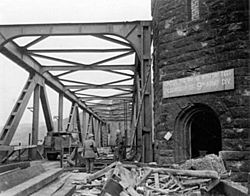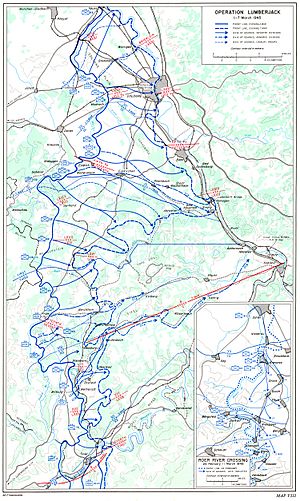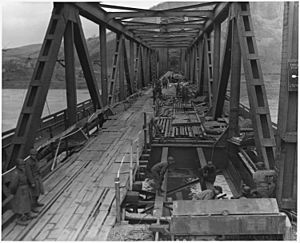Operation Lumberjack facts for kids
Quick facts for kids Operation Lumberjack |
|||||||
|---|---|---|---|---|---|---|---|
| Part of the Western Allied invasion of Germany in the Western Front of the European theatre of World War II | |||||||
 American forces cross the Ludendorff Bridge at Remagen |
|||||||
|
|||||||
| Belligerents | |||||||
| Commanders and leaders | |||||||
| Strength | |||||||
| Casualties and losses | |||||||
|
7,400
|
5,700+ killed & wounded 19,000 captured Total: 24,700 casualties |
||||||
Operation Lumberjack was a military operation during World War II. It aimed to capture the west side of the Rhine River in Germany. This was near the end of the war in Europe. The First United States Army started this operation in March 1945. Their goal was to take important German cities. They also wanted to get a strong position along the Rhine River for the Allied forces.
A big surprise during this operation was the capture of the Ludendorff Bridge. This was a very important railroad bridge over the Rhine. The German forces tried to blow up the bridge, but they failed. Allied soldiers captured it whole. They used the bridge for ten days to cross the river. This created a "bridgehead" on the other side. The bridge finally collapsed on March 17, 1945. It had been hit by bombs, artillery, and demolition attempts.
Contents
Why Operation Lumberjack Happened
The Germans had made it very hard for the Allies to cross the Rhine River. This river was a major natural barrier. The Allies had a large group of armies, called the 12th Army Group. Their leader, U.S. General Omar Bradley, planned Operation Lumberjack.
Bradley's plan was for the U.S. First Army to attack southeast. They would move towards where the Ahr River meets the Rhine. Then, they would turn south. At the same time, General George S. Patton's U.S. Third Army would attack northeast. They would move through the Eifel region. If successful, Operation Lumberjack would capture the city of Cologne. It would also secure the Koblenz area. This would bring the 12th Army Group to the Rhine River. The Allies also hoped to capture many German soldiers.
After Operation Lumberjack, the Allies planned to pause at the Rhine. Then, another large operation called Operation Plunder would begin. This operation, led by General Montgomery, would cross the Rhine near Düsseldorf. Its goal was to capture the Ruhr region. This was Germany's industrial heartland.
Allied Forces in the Operation
During Operation Lumberjack, the U.S. First Army included several important groups of soldiers:
- III Corps led by Major General John Millikin. This included the 9th Armored Division, 1st Infantry Division, 9th Infantry Division, and 78th Infantry Division.
- V Corps led by Major General Clarence R. Huebner. This included the 2nd Infantry Division, 28th Infantry Division, 69th Infantry Division, and 106th Infantry Division.
- VII Corps led by Major General J. Lawton Collins. This included the 3rd Armored Division, 8th Infantry Division, 99th Infantry Division, and 104th Infantry Division.
The U.S. Army's 9th Armored Division had a special job. They were to clear out any German soldiers left on the west side of the Rhine. They also had to stop any German counterattacks. The First Army's main goal was to take control of the entire area west of the Rhine. After capturing Cologne, they would move southeast to meet Patton's Third Army. Patton's army was supposed to capture the Eifel Mountains and the Mosel Valley. This would trap the remaining German Seventh Army.
German Forces
The American forces faced several German armies. From north to south, these included:
- The German Fifteenth Army' led by General Gustav-Adolf von Zangen.
- The German Fifth Panzer Army' led by General Hasso von Manteuffel.
More than 75,000 German soldiers were on the west side of the Rhine. Their only way to escape was across the Ludendorff Bridge.
It was very difficult for German officers to decide when to destroy bridges. An American bomb had accidentally blown up the Mulheim Bridge in Cologne in October 1944. This happened because demolition charges were already in place. Adolf Hitler was very angry about this. He ordered that explosives should only be put on bridges at the very last moment. This was when the Allies were within 5 miles (8 km) of the bridge. Bridges could only be destroyed with a written order from the officer in charge. This made officers nervous. They worried about blowing up a bridge too soon or not blowing it up at all.
The Battle Begins
General Bradley started Operation Lumberjack on March 1. In the north, the First Army quickly crossed the Erft River. They entered Euskirchen on March 4. They reached Cologne on March 5. Cologne was under U.S. Army control by March 7. The First Army then pushed towards the Ahr River valley. This was where the remaining German soldiers were likely to retreat.
The U.S. Third Army faced some resistance. This was along the Siegfried Line and the Prüm and Kyll Rivers. On March 4, at Bitburg, the 5th Infantry Division broke through the German lines. The Fourth Armored Division then drove 45 miles (72 km) to the Rhine in less than five days. They lost only 100 soldiers. But they caused 5,700 German soldiers to be killed or wounded. The Fourth Armored Division almost captured a bridge at Urmitz.
While moving towards the Ahr River, the U.S. 9th Armored Division moved quickly towards the Rhine. The faster they moved, the closer they got. Their speed surprised the Germans. About 12 miles (20 km) upstream from Bonn, they found the Ludendorff Bridge still standing. This was completely unexpected.
The Battle of Remagen
On March 7, 1945, during Operation Lumberjack, soldiers from the U.S. Army's 9th Armored Division reached the Rhine River. They were very surprised to see that the railroad bridge was still standing. This was the Ludendorff Bridge. It was one of only two damaged but usable bridges over the Rhine. The U.S. forces were able to capture it. The Rhine River was the last natural defense line for the Germans. They hoped it would stop the Allied advance. Until then, Allied crossings had been small patrols by boat.
When General William Hoge heard the bridge was still standing, he ordered his troops to advance into Remagen. German demolition charges failed to destroy the bridge. U.S. troops then captured the bridge. Over the next ten days, 25,000 soldiers from six divisions crossed the bridge. They created a wide "beachhead" on the eastern side of the Rhine.
How the Bridge Capture Changed War Plans
Capturing the Ludendorff Bridge changed the Allied high command's plans. They realized they could now surround the German industrial area of the Ruhr. Before, they had focused mainly on General Bernard Montgomery's plan, Operation Plunder. That plan would have brought British forces across the Rhine further north.
The unexpected capture of the first major crossing over the Rhine changed everything. This was Germany's last big natural barrier. Allied commander Dwight D. Eisenhower changed his plans to end the war. Being able to quickly get soldiers across the Rhine into Germany allowed U.S. forces to surround the Ruhr. The Allies got six divisions across the Rhine before the Ludendorff Bridge collapsed. This happened ten days after it was captured, on March 17. Twenty-five soldiers died or went missing when it collapsed. Sixty-three others were injured. Before it fell, five U.S. divisions had already used it. They also used two nearby temporary bridges. This created a strong bridgehead. It was almost 25 miles (40 km) long and 6 to 9 miles (10 to 15 km) deep.
The bridge was not rebuilt after the war. However, its towers still stand. In 1980, a peace museum opened there.
What Happened Next
Operation Lumberjack successfully cleared the Rhine River area north of the Mosel River. The German forces there were no longer effective. The Allies destroyed four groups of soldiers from the German 15th and 7th Armies. Capturing the bridge at Remagen was an unexpected bonus. It helped the Allies cross the Rhine much sooner than planned. Generals Patton and Bradley were able to move up their own planned Rhine crossings.
General Albert Kesselring called the battle the "Crime of Remagen." He said it "broke the front along the Rhine." Hermann Göring said that capturing the bridge "made a long defense impossible." Major General Carl Wagener, a German staff chief, said that capturing the bridge meant the end of the war for the Germans:
The Remagen event caused a big stir in the German Supreme Command. Remagen should have been seen as a reason to end the war. Remagen created a dangerous and unpleasant problem within Germany's last defenses. It also gave the enemy an ideal starting point for their next attack east of the Rhine. The Remagen bridgehead made other Rhine crossings much easier for the enemy. Also, it tired out German forces that should have been resting for the next big attack.
See also




